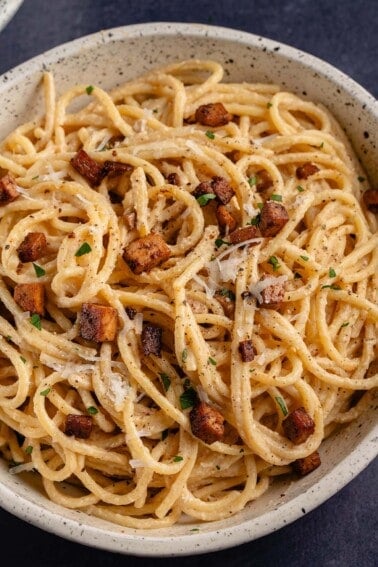This post may contain affiliate links. Please read our disclosure policy.
In honor of Earth Day and Earth Month, we decided we wanted to share about the environmental impact of veganism and why going vegan is so beneficial for not only our health and the animals, but for our planet as well. We know that we are posting this after they have just past, but we figured that it is never too late to share this information!
Animal agriculture is much more than just a health issue for humans–it is also an environmental issue. Below we outlined facts linking animal agriculture to environmental destruction. A vegan lifestyle is the best way to reduce your carbon footprint and make a difference daily–we hope this will inspire you to make more conscious changes to your lifestyle and diet in the future!

Water Use
In order to make a dent in our water use, a lot of people turn to lessening their shower times, water use during brushing their teeth and even removing their lawns and choosing more eco-friendly landscaping instead. Of course, all of these are wonderful and I’m glad that these changes are being made, but something that needs to be considered is water use when it comes to agriculture.
More than 70% of the earth’s fresh water is used in agriculture of plants and animals. Did you know that it takes 100-200 times more water to produce a pound of beef than it does to grow a pound of plant foods? Along with this, the United Nations has reported that the livestock sector is most likely the largest source of water pollution.
Animal agriculture accounts for one-third of all consumptive global freshwater use and over one-half of consumptive U.S. freshwater use.
Most of that water is from the growing of food for them to eat, and plenty is also needed to service and slaughter them.
Deforestation and Land Use
About 91% of all Amazon deforestation is due to animal agriculture, and over the past 25 years, the amount forest that has been cleared equals the size of India. Livestock is said to cover about 45% of the total land on earth!
On 1.5 acres of land, you can either produce 37,000 lbs of plant-based food or just 375 lbs of meat in contrast. With this, it is clear that plant-based foods are more sustainable and environmentally friendly!
Climate Change
Can we eat our way out of climate change? Yes! There is evidence that shows that changing the way we eat can have a big impact on climate change.
Agriculture and land use is responsible for nearly a quarter of all global greenhouse gas emissions. The biggest culprit is livestock, particularly cattle. Beef generates between 9-27 times the amount of global warming pollution than an equivalent number of calories of beans, nuts, and vegetables.
Different foods have different carbon footprints. For example, let’s take a look at animal and plant protein sources. If you swap steak for fish, you get an eight-fold reduction in emissions, but if you swap that for beans or lentils, your emissions drop to near zero.
The billions of farmed animals in U.S. factory farms produce enormous amounts of methane. In fact, the U.S. Environmental Protection Agency (EPA) has shown that animal agriculture is globally the single largest source of methane emissions. Methane, pound for pound, is more than 25 times as effective as carbon dioxide at trapping heat in our atmosphere.
Did you know that animal agriculture produces about 4 times as much global greenhouse gas emissions than all of transportation combined (road, rail, air, and marine)?
The U.N. believes that a global shift toward plant-based food is vital if we are to combat the worst effects of climate change, stating that raising animals for food is “one of the top two or three most significant contributors to the most serious environmental problems, at every scale from local to global.”
An Oxford University study, published in the journal Climatic Change, shows that meat-eaters are responsible for almost 2 times as many dietary greenhouse-gas emissions per day as vegetarians and about two and a half times as many as vegans. That means that a vegan diet cuts your carbon footprint by 50%.
Oceans
Feed for animals needs to be produced at a high rate in a small amount of time, so this calls for a higher use of chemicals and fertilizers which are a big contributor to the creation of dead zones.
What are Dead Zones? A dead zone is an area at the bottom of the ocean that is oxygen depleted and cannot maintain any marine life. The biggest cause of dead zones is an overflow of fertilizers, sewage and industrial pollutants being pumped into rivers all over the world. These cause excessive overgrowth of algae which sinks and decomposes in the water. This decomposition consumes all the available oxygen so that marine life can no longer survive there. Dead zones can occur naturally, but human-related causes are considered to have the biggest impact.
Today there are now over 530 dead zones which in total encompass 95,000 square miles. Since no one sees them, they are largely ignored. Thankfully, it has been proven that dead zones are reversible. Between 1991-2001, the dead zone in the Black Sea largely disappeared. This happened unintentionally and was the result of fertilizers being too costly to buy following the collapse of the Soviet Union, along with a decrease in the manufacturing of other industrial products.
The flatulence and feces of these animals are produced in such large amounts that they are creating a modern-day problem. They release air pollutants, and it is the country’s fastest-growing large source of methane, a greenhouse gas. They are put into toxic open-air cesspools which leach into rivers, ponds, wells etc. and eventually our beloved ocean.
Commercial fishing is one of the greatest threats to marine life and many species are on the brink of extinction. When nets sweep the seabed, they can destroy coral and marine plants, and every year an estimated 300,000 cetaceans (whales, dolphins, and porpoises) are killed as “by-catch” after being caught in fishing nets, while turtles, seals, and birds also die from injuries caused by nets and tackle.
Fish and other sea animals are capable of feeling pain and suffering as are all sentient beings. When pulled from the ocean, fish undergo excruciating decompression – the internal pressure causes their swim bladders to rupture, pops their eyes out of their heads, and pushes their stomachs out through their mouths. Many slowly suffocate in fishing vessels, while others are still alive when their throats and bellies are slit open. Crustaceans also feel pain and suffer when they’re taken from their ocean homes and cut, broiled, or boiled alive.
You can help end this suffering and reduce environmental destruction by going vegan. There are o many amazing vegan products, brands and alternatives on the market, so we encourage you to try them out and make a change for the better of our planet!
Check out The Vegan Calculator— a website that estimated how many gallons of water, square feet of forest, pounds of CO2, pounds of grain and animal lives that you save over a certain period of time a vegan diet.
Sources:














Thanks Guys always timely and important information.
Nice article. Very informative and to the point.